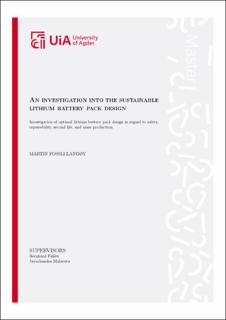| dc.description.abstract | The global demand for electricity is rising due to the increased electrification of multiple sectors. Whereof electrical vehicles are becoming increasingly popular. In addition, the European Parliament issued a ban on emission vehicles by 2035. Lithium-ion batteries have become one of the main energy storage solutions in modern society. Where the production and use is expected to continuously increase in the near future. However, the handling of end-of-life lithium-ion batteries must be addressed considering that a massive number of lithium batteries that are not refurbished for second life systems will retire and enter the waste stream at the same rate just at a delay of 8-15 years. Furthermore, the process of EV battery pack repair is currently unutilized except for some trial facilities. While the second life of EV batteries just recently started to exploit the energy and economics that went into battery production by utilizing the remaining battery capacity. While The optimization of recycling processes and technologies, and the current recycling are still under development.
This thesis demonstrates the need for design changes in mass production to facilitate battery repair and the possibility of introducing second life battery systems. In addition to making further development of recycling methods possible.
The four pillars of this thesis are safety, second life, recycling, and mass production. This study contributes to this by identifying factors that affect these pillars in relation to lithium-ion battery packs. This is achieved by a systematic literature review and applying a PEST analysis (political, economic, social, and technological factors). Followed by implementations based on a SWOT (strengths, weaknesses, opportunities, and threats) analysis meant to challenge the current norms in li-ion battery pack production. Furthermore, this thesis presents comprehensive results and a discussion of the interconnection and the contradictory design optimization for the four pillars.
The results indicate that given the proper incentives, industry norms can change to better accommodate the complete life cycle of the lithium-ion battery. Ultimately allowing for battery pack repairs, better conditions for the profitability of second life, and the development of more efficient recycling processes. | |
